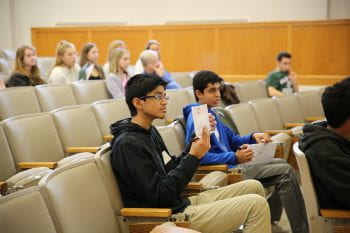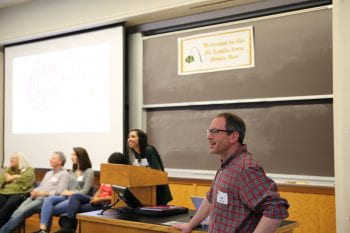“Sonic hedgehog is important for the development of what part of the nervous system?”
With his answer (spinal cord, also accepted cerebellum) Akhil Kondepudi, a junior at Ladue Horton Watkins High School, clinched the 2018 St. Louis Area Brain Bee. An annual neuroscience competition held at Washington University in St. Louis.
His top showing was hardly a surprise to many in attendance. Hours earlier he sped through a 51-question multiple-choice test of brain knowledge, finishing it in 13 minutes.

“I really like neuroscience. I am here to win. I came to compete and to have fun,” Akhil said during a pause in activity.
Akhil’s journey to the championship started last year when he took second place. Undeterred, he trained hard reading the Brain Facts book provided by the Society for Neuroscience which runs this international competition, and even went a step farther and read from some textbooks.
“He’s a very special kid,” said Erik Herzog, the event organizer, a professor of biology and a faculty fellow for the university’s Institute for School Partnership. “It’s nice to see him come back and compete again.”
“My heart was beating so fast,” said Akhil’s mother Prasanna Kondepudi of watching her son. “I was sweating, it was really nerve wrecking.”
She said Akhil worked really hard and knew his stuff. She feels this win will boost his confidence.
As the winner, Akhil earned a summer research fellowship at a WashU laboratory and an all-expenses-paid trip to the National Brain Bee in Maryland this March.
We were going way deeper in the questions then we have in the past
Launched in 2010, the St. Louis Area Brain Bee has grown every year. This year, some 40 high school students took the multiple-choice test with 10 moving on to the oral competition. Like a spelling bee, students then take turns answering questions about the brain.
Herzog said this year’s finalists were exceptional. He admits he was concerned he was going to run out of questions.
“We were going way deeper in the questions than we have in the past,” he said. “They went to about 58 questions, and I had about 10 more left.”

Members of Synapse, WashU’s neuroscience club, assisted with the event and guided the high school students through the activities. In addition to The Bee, students also took part in hands-on activities such as holding a human brain, and participated in a neuroscience panel discussion.
One of the panelist was Jasmine Brown, a senior in Arts & Sciences, and a recently named Rhodes Scholar. As a high schooler, she took part in a brain bee and found it really rewarding.
“It was really exciting because it was the first time I was around other students who were interested in neuroscience,” she said. “I was already down the path of neuroscience but it inspired me to get into research.”
Herzog said the competition isn’t about crowning a king or queen but educating participants about the brain, setting a foundation for a possible career in neuroscience, introducing students to a network of people interested in brain studies and engaging them in hands-on science activities.
“I hope I connected them with a community that they’ll want to stay in touch with,” he said. “We want to make this about learning. Most of the day is not about the competition.”
Second place winner Shelei Pan is also a student at Ladue Horton Watkins High School. She was a repeat participant, having taken third place last year. The other top 10 finalists were (in no particular order) Rohith Ryali, Varun Shenoy, Trey Wang, Seunju Lee, Sriya Bondi, Shriya Koneru, Rincon Jagarlamundi and Keerthana Madireddi.
The next St. Louis Area Brain Bee will be in February 2019 with more questions about sonic hedgehog to stimulate teenagers to learn about neuroscience.
February 2018 | by, Myra Lopez
